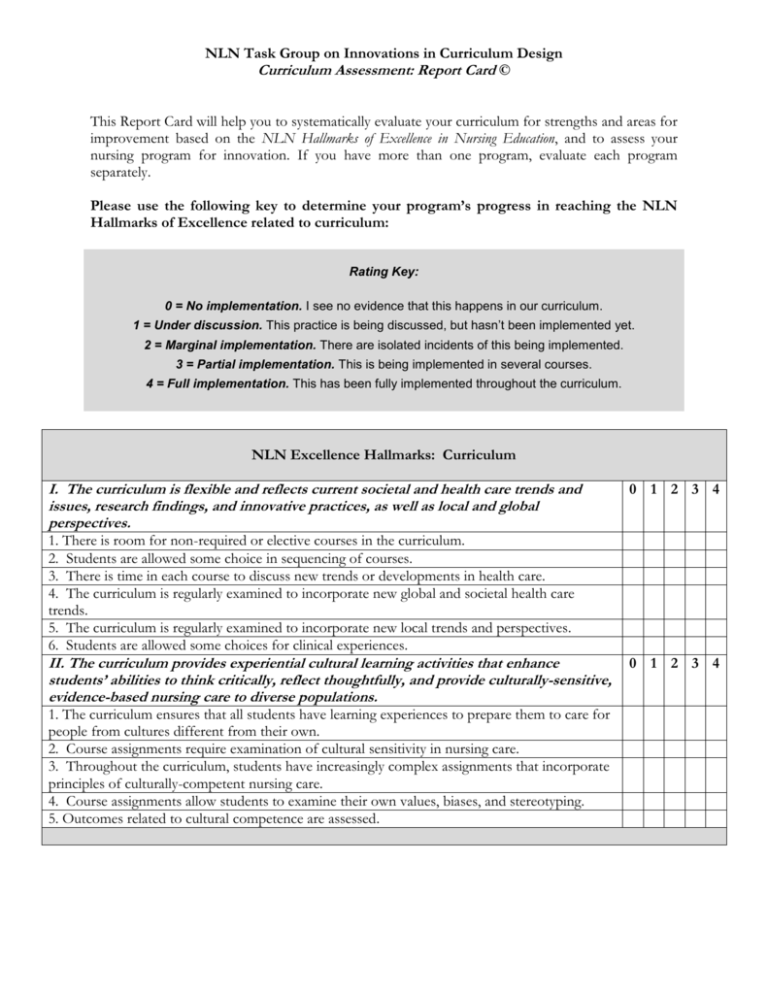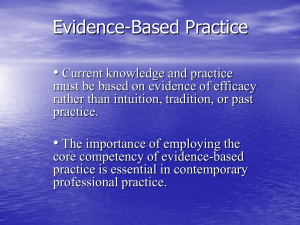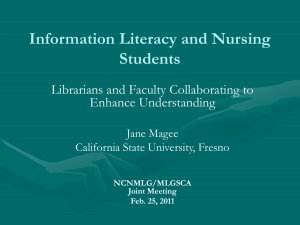a curriculum report card (DOC)
advertisement

NLN Task Group on Innovations in Curriculum Design Curriculum Assessment: Report Card © This Report Card will help you to systematically evaluate your curriculum for strengths and areas for improvement based on the NLN Hallmarks of Excellence in Nursing Education, and to assess your nursing program for innovation. If you have more than one program, evaluate each program separately. Please use the following key to determine your program’s progress in reaching the NLN Hallmarks of Excellence related to curriculum: Rating Key: 0 = No implementation. I see no evidence that this happens in our curriculum. 1 = Under discussion. This practice is being discussed, but hasn’t been implemented yet. 2 = Marginal implementation. There are isolated incidents of this being implemented. 3 = Partial implementation. This is being implemented in several courses. 4 = Full implementation. This has been fully implemented throughout the curriculum. NLN Excellence Hallmarks: Curriculum I. The curriculum is flexible and reflects current societal and health care trends and issues, research findings, and innovative practices, as well as local and global perspectives. 0 1 2 3 4 1. There is room for non-required or elective courses in the curriculum. 2. Students are allowed some choice in sequencing of courses. 3. There is time in each course to discuss new trends or developments in health care. 4. The curriculum is regularly examined to incorporate new global and societal health care trends. 5. The curriculum is regularly examined to incorporate new local trends and perspectives. 6. Students are allowed some choices for clinical experiences. II. The curriculum provides experiential cultural learning activities that enhance students’ abilities to think critically, reflect thoughtfully, and provide culturally-sensitive, evidence-based nursing care to diverse populations. 1. The curriculum ensures that all students have learning experiences to prepare them to care for people from cultures different from their own. 2. Course assignments require examination of cultural sensitivity in nursing care. 3. Throughout the curriculum, students have increasingly complex assignments that incorporate principles of culturally-competent nursing care. 4. Course assignments allow students to examine their own values, biases, and stereotyping. 5. Outcomes related to cultural competence are assessed. 0 1 2 3 4 Rating Key: 0 = No implementation. I see no evidence that this happens in our curriculum. 1 = Under discussion. This practice is being discussed, but hasn’t been implemented yet. 2 = Marginal implementation. There are isolated incidents of this being implemented. 3 = Partial implementation. This is being implemented in several courses. 4 = Full implementation. This has been fully implemented throughout the curriculum. III. The curriculum emphasizes students’ values development, socialization to the new role, commitment to lifelong learning, and creativity. 0 1 2 3 4 1. Students are given permission to think “outside the box” when engaged in learning experiences. 2. Grading rubrics are structured such that students are rewarded for creativity and/or originality of thought. 3. Course assignments/clinical experiences are designed to promote students’ socialization into the nursing role. 4. Individual learning styles are appreciated and enhanced through a variety of learning experiences. 5. Learning strategies integrate the generational differences among students to promote positive educational outcomes. 6. Learning experiences require values clarification and student development in the affective domain. 7. Faculty design learning experiences that focus on career development and student appreciation of life-long learning. IV. The curriculum provides learning experiences that prepare graduates to assume roles 0 1 2 3 4 that are essential to quality nursing practice, including but not limited to roles of care provider, patient advocate, teacher, communicator, change agent, care coordinator, user of information technology, collaborator, and decision maker. 1. Learning experiences are implemented to assist students in the following role development, including roles of: a. care provider. b. patient advocate. c. teacher (individual and group). d. communicator (writing and speaking). e. change agent. f. care coordinator. g. technology user (to include electronic records and databases). h. collaborator. i. decision maker. Rating Key: 0 = No implementation. I see no evidence that this happens in our curriculum. 1 = Under discussion. This practice is being discussed, but hasn’t been implemented yet. 2 = Marginal implementation. There are isolated incidents of this being implemented. 3 = Partial implementation. This is being implemented in several courses. 4 = Full implementation. This has been fully implemented throughout the curriculum. V. The curriculum provides learning experiences that support evidence-based practice, multidisciplinary approaches to care, student achievement of clinical competence, and, as appropriate, expertise in a specialty role. 0 1 2 3 4 1. Evidence-based practice concepts are taught throughout the curriculum. 2. Students’ work in clinical environments where evidence-based practice is valued. 3. Students have experience with multidisciplinary approaches to patient care. 4. Innovative learning experiences are created to help students develop clinical competence. 5. Students have experience as members and leaders of multidisciplinary teams. 6. Students have substantial learning experiences to prepare them as experts in the full scope of their new role (new graduate nurse, advanced practice roles, educators, administrators, or researchers). 7. Students have learning experiences to achieve clinical competencies to prepare them to meet demands and requirements of entry level nurses in a variety of settings. VI. The curriculum is evidence-based. (Programs should ask themselves how the current 0 1 2 3 4 curriculum is evaluated based on outcome evidence.) 1. Research has been used to determine how the curriculum is designed. 2. Current research is used to help faculty determine when to make changes in the curriculum and what those changes will be. 3. Assessment of program and student outcomes is done regularly to provide evidence for curriculum revision, planning, and implementation, including: a. surveys of alumni, graduates and employers. b. benchmarking (comparing results with similar programs) i.e. financial health of institution, applicant pool, admission, retention, graduation rates, diversity, faculty satisfaction. 4. Formative evaluations of student progress are used as evidence for curriculum revision, planning, and implementation, including: a. course evaluations by faculty. b. student achievement (GPA, on-time progression through program courses, preceptor feedback about student performance). c. staff, student, faculty satisfaction. d. impression of student and faculty performance by clinical agency personnel. e. assessment of student services and other support systems. f. critical-thinking development (i.e. PBDS systems). g. NCLEX readiness. h. satisfaction surveys of families of students. i. cost effectiveness of program. j. student course evaluations. k. faculty teaching effectiveness (peer review, course surveys completed by students, self evaluation). Rating Key: 0 = No implementation. I see no evidence that this happens in our curriculum. 1 = Under discussion. This practice is being discussed, but hasn’t been implemented yet. 2 = Marginal implementation. There are isolated incidents of this being implemented. 3 = Partial implementation. This is being implemented in several courses. 4 = Full implementation. This has been fully implemented throughout the curriculum. NLN Excellence Hallmarks: Innovation VII. The design and implementation of the program is innovative and seeks to build on traditional approaches to nursing education. 1. Rationale for innovation is supported by evidence and/or guided by the literature. 2. Faculty and students systematically evaluate the impact of innovative teaching and curriculum approaches on student learning, student satisfaction, and other student-centered outcomes. 3. Innovative aspects of the curriculum are evaluated. 4. Faculty have the requisite knowledge and skills to identify, plan, implement, and evaluate curricular innovations. 5. When barriers to innovation occur, the faculty are able to identify and implement strategies for success. 6. Faculty, students, and alumni can identify the features of the program that are truly innovative. 7. The faculty are committed to challenging traditional approaches to nursing education and implementing more innovative, evidence-based approaches. 8. There is administrative support for faculty to be innovative in their approach to teaching and learning, as well as in their approach to the design, implementation, and evaluation of the curriculum. 9. Resources and support for faculty development related to innovative curriculum are clearly evident. 10. A culture of innovation (such as risk-taking, diverse thinking, and challenging long-held assumptions) is celebrated. 0 1 2 3 4








